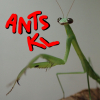Body:
1. Location: Indianapolis, IN. Spotted her crawling on the wall of my house while on the back porch.
2. Date of collection: 5/22/21
3. Habitat of collection: Lightly wooded residential area, found on back porch
4. Length: ~18mm
5. Coloration, hue, pattern and texture: Black head and thorax. Red coloration on gaster and legs.
6. Distinguishing characteristics: Large gaster with red coloration
7. Anything else distinctive: She felt cozy enough in the test tube to lay eggs after less than a week.
8. Nest description: N/A
9. Nuptial flight time and date: She had already shed her wings when I captured her on 5/22
The last queen I caught in my backyard was pretty clearly Camponotus pennsylvanicus, this one seems to have a fatter gaster and the red coloration as main differences. Does pennsylvanicus sometimes have coloration?
Edited by Roll Me-Wan Kenobi, May 29 2021 - 11:45 PM.















